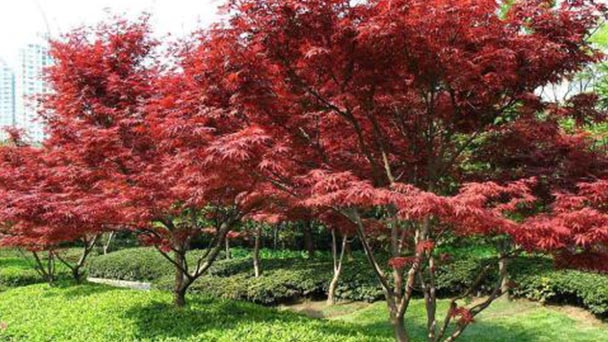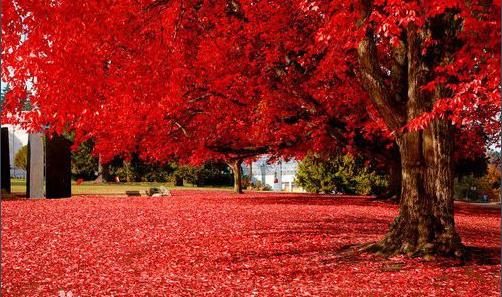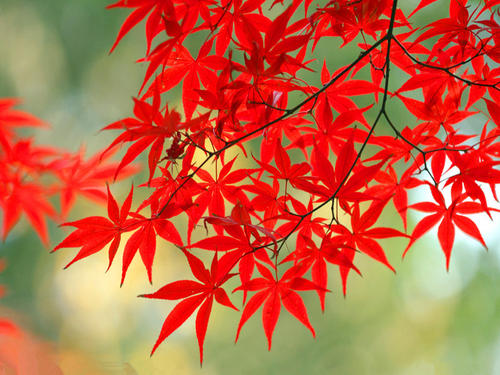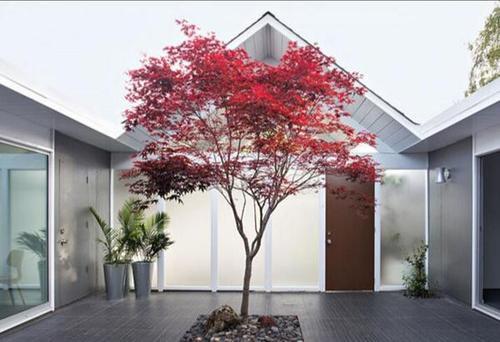Japanese maple profile
Written by Maggie
Feb 01 2021

Japanese Maple, the scientific name Acer palmatum, is a small deciduous tree or shrub. Its plants are not very tall, but the tree shape is well-balanced and the overall sense of harmony is strong. Japanese Maple has an oblate or umbrella-shaped crown both of which are relatively large and can also provide protection.
Japanese maple picture

Japanese maple features
Japanese Maple is a deciduous small tree or shrub. Japanese Maple is oblate or umbellate in the crown, palmate in leaf shape with 5-9 deep lobes, alternate in single leaves, sharp at leaf apex, serrate at the leaf margin, purple or red in color, ovate-lanceolate in color, red in spring, summer, and autumn, especially in spring and autumn; The leaves of Japanese Maple are bright red in season and turn brownish-red in midsummer. Japanese Maple is known as the "Four Seasons Flame Maple". After the winter leaves are gone, its strange and ornamental branches still add to the landscape of winter gardens. Japanese Maple is a well-known leaf-watching tree.
Japanese Maple bark is dark gray. Branchlets are thin; Current shoots are purple or lavender green; Perennial branches are grayish purple or dark purple.
Leaves of Japanese Maple are paperious, oblong in appearance, 7 -- 10 cm in diameter, basally cordiform or nearly cordiform thinly truncated, 5-9 palmately divided, usually 7-lobed, lobes oblong-ovate or lanceolate, apex acute or long acute, margin closely acutely serrate; Recess if Japanese Maple is between lobes obtuse or acute, to half leaf diameter, upper dark green, glabrous; Underneath is pale green, white tufts in vein axils of veins; Main veins of Japanese Maple are slightly prominent above, raised below, thin, glabrous.
Japanese Maple flowers are purple, heterozygous, male and bisexual, born in glabrous cymose, flowering only after the leaves have been emitted; Japanese Maple has 5 sepals, ovate-lanceolate, apex acute, 3 mm long; Japanese Maple has 5 petals, elliptic or obovate, apex obtuse, ca. 2 mm; Japanese Maple has 8 stamens, glabrous, slightly shorter than petals and hidden within them; Disk is lateral to stamen, lobed; Ovary is glabrous, style long, 2-lobed, stigma flat, pedicel ca. 1 cm, thin, glabrous.
Japanese Maple samara is purplish red when young and pale brownish yellow when ripe; Japanese Maple nutlets spherical, veined conspicuously; It expands at obtuse angles.
Japanese maple growth habits
Japanese Maple likes a cool and humid climate environment, Japanese Maple has good resistance to negative and grows strongly and quickly in loose, fat and well-drained soil, but in summer when there is strong direct sunlight, the leaves are easy to burn.
Japanese maple distribution
Origin from Japan, Japanese Maple is a Japanese horticultural variety, and many temperate gardens have introduced horticultural variants of Japanese Maple.
Japanese Maple landscape utility
The Japanese maple tree is graceful, new leaves in spring and summer are red, leaf color bright beautiful, old leaves have turned green, new varieties of plants is excellent foliage gardens, both solitary planting, group planting and as trees grow, to be able to "red sleeve dancing clouds" fiery charm, let people enjoy them, pick up, is excellent foliage garden plant varieties. The view is especially beautiful if the Japanese Maple is set against the background of evergreen trees or white walls.

Japanese maple propagation methods
Japanese maple is mainly propagated in the spring by grafting, and the rootstocks are 1- to 2-year old maples such as Maples japonicus and Acer japonicus. After grafting, the Japanese Maple should be promptly wiped out the germination on the stock and untied at the right time. In winter, after falling leaves, it is the best time for planting. It is advisable to plant sparsely when planting, so as to increase and improve the ventilation and light transmission conditions between seedlings and promote the flourishing of the tree crown. Usually, management and maintenance to apply thin fertilizer, increase the application of phosphorus, potassium fertilizer, control the amount of nitrogen fertilizer, otherwise easy to make the leaf color green.
Japanese maple growing methods
Planting Japanese Maple can be used in general cultivation soil, after watering in the half shade. Spray the branches often. Light can be increased when the leaves begin to spread. Apply a light (nitrogen) fertilizer after all the leaves have been developed. Place Japanese Maple in a sunny and semi-shaded place for normal management.
Pay attention to ventilation in summer and autumn. Potted around noon should be moved to the half shade, and pay attention to ventilation. In the scorching sun exposure, leaf should be coke edge, curl, deciduous. Also pay attention to water to prevent the soil from drying out.
If you want to artificially control the viewing of Japanese Maple leaves, you can do it in the two periods between spring and summer and summer and autumn. Too much work kills the tree. You can pick the leaves once in summer and once in autumn, and the bright red leaves will come out 10 days later. Two points should be noted: one is to prune after picking leaves; The second is to fertilize the Japanese Maple leaves one week before picking them. Artificial control of new leaves, fertilizer and water to strengthen, this is the key to success.
If the leaves are scorched under the hot sun, the scorched leaves can be removed completely in summer, placed in a cool and semi-shady place, and applied with NPK compound solution, lightly applied, about 2 times a week. In this way, in the autumn, there will be bright red new leaves of Japanese Maple.
After falling leaves in the winter enters dormant period of Japanese Maple, but thin application of nitrogen phosphate potassium base fertilizer, undertake plastic pruning, so next year the branches and leaves of early spring are more Hongyan. Such as encounter strange cold special weather, bonsai should be placed in the warm place or indoor sun shelter, so as not to freeze bad.
Japanese Maple disease and control
The main diseases and insect pests of Japanese Maple are red wax scale insect, blowing cotton scale insect, heart borer, aphid and so on. Scale insect prevention method: a small amount of brush with a toothbrush, serious, with 25% imine phosphorous sulfur emulsion 1000 times the spray. Prevention of heart bores: inject 40% diethoate 2000 times solution into the trunk pests with a syringe. Insect-eating pests of Japanese Maple such as the scarab, moth, aphid nibble on the leaves of red maple, resulting in poor growth of seedlings, the need to use avermectin, Capri, oxate 800 to 1000 times for spray; Dry-worming pests of Japanese Maple such as longicorn beetles and heart bores can harm the branches of red maple, causing the dead branches or even the whole plant to die. It is necessary to spray the branches of Japanese Maple with methamiphos and Dichlorvos solution at the insect entrance, and seal the branches with mud mouth.

Latest Updated
- Benefits of Bugleweed - 7 Science-backed Health Benefits
- Bugleweed Dangers & Side Effects - Is It Poisonous?
- How to Plant Evergreen Trees - What You Should Know
- When to Plant Evergreens - Grow Guide for Evergreen Trees
- 12 Wonderful Evergreen Shrubs for Your Garden
- 12 Popular Evergreen Plants with Pictures for Beginners
- When And How To Prune A Lilac Bush Like a Pro
- How to Grow & Care for Lilac Vine (Hardenbergia Violacea)
- Japanese Lilac Tree (Syringa Reticulata) Care & Propagation Guide
- Shumard Oak Pros and Cons - What to Know
Popular Articles
- Winter maintenance of Antirrhinum Majus
- How to Grow Terminalia Mantaly Tree
- How to Grow and Care for Crossostephium Chinense
- How to grow Antirrhinum Majus in spring
- Peristeria Elata (Dove Orchid) Profile: Info & Care Guide
- Underwatered Snake Plant (Sansevieria Trifasciata) - Signs And How To Fix
- How to Care for Brazilian Jasmine Plant (Mandevilla Sanderi)
- How to Grow & Care for Graptopetalum Purple Delight in Summer
- Rosa Chinensis (China Rose): Plant Growing & Care Tips
- How to Care for Baby Sun Rose (Aptenia Cordifolia)